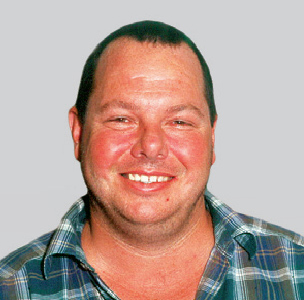
ARC-Grain Crops, Potchefstroom
Sclerotinia sclerotiorum is a damaging fungal pathogen, causing disease on a range of crops, including soybeans, beans, canola and lupines as well as a variety of vegetable crops. It also causes Sclerotinia head and/or stalk rot on sunflowers.
S. sclerotiorum has an extensive host range, which possibly exceeds over 500 plant species.
These include crops as well as many weed species, which may all serve as alternate hosts for the pathogen. This means that once the disease is in an area or field, it is extremely difficult or almost impossible to eradicate. In some areas such as Mpumalanga, it is one of the primary reasons that sunflowers are no longer a viable alternate crop to maize.
The continuous spread of the disease on both sunflowers and soybeans toward the western maize production areas is reason for concern. The inoculum levels may become so high that both these crops may become uneconomical to plant, thus removing the two most important rotation crops in this maize production area. This article will focus on Sclerotinia head and stalk rot of sunflowers. It will be followed by an article on Sclerotinia diseases on soybeans.
Sclerotinia stalk rot of sunflowers is not a major threat to sunflower production in South Africa, with isolated plants in a field being infected. In various other sunflower-producing countries, stalk rot is the primary disease caused by this organism. However, Sclerotinia head rot of sunflowers has caused major damage in South Africa, particularly in late-planted crops that ripen in cool, wet conditions. Recently this disease has continued to spread in local sunflower production areas with high incidences – up to 90% – being recorded in fields in the North West Province and northern Free State.
Incidences vary seasonally at a specific locality, depending on planting date and climatic conditions. This seasonal variation is common, but if the disease does not occur in a season at a given locality with a history of Sclerotinia head rot, it cannot be assumed the land is free of disease. Sclerotia of S. sclerotiorum have been recorded to live up to seven years in the soil; so inoculum may be present waiting for favourable conditions to infect. The disease may again come to the fore the following season should favourable conditions prevail.
In recent online surveys (sunflower and soybeans) of the South African Sclerotinia Research Network (SASRN) between 2019 and 2021, where producers reported to Dr Lisa Rothman from the Free State University, a total of 16 responses were provided with a majority (n = 14) of the reports from the 2019/2020 season. Sunflower producers from the Free State (n = 4) and North West (n=4), as well as six soybean producers from Mpumalanga and one producer from KwaZulu-Natal provided estimates of Sclerotinia stalk and head rot from their current seasons. The disease intensity estimates provided for sunflower head and stalk rot ranged between 10% and 60%.
As said earlier, the continued spread of this disease through the sunflower production areas over time is cause for major concern. This continued spread is from land to land when apothecia form on the soil surface and spores are released into the air. Sclerotia are also spread in seed batches that are generally checked, but as sclerotia look very similar to a sunflower seed, they are often overlooked. Seed certification does allow a low number of sclerotia in a seed batch.
It takes just a few sclerotia to infect a land, increasing annually as head rot or stalk rot until it reaches epidemic proportions and sunflower yields are reduced to levels where planting the crop becomes uneconomical. Increased disease pressure will also impose an increased threat on production of other susceptible crops, in particular soybeans.
The wide host range infected by the disease and increased disease pressure will indirectly affect maize production by reducing much needed crop rotation options, particularly where conservation tillage practices are on the increase. A lack of alternate crops in crop rotation systems will force producers to plant maize under monoculture, which – particularly under conservation tillage systems – brings a different set of disease problems on maize crops.
Should the 2021/2022 season’s rains continue until grain fill, one can expect increased levels of disease and serious sunflower yield losses.
Symptoms of the two diseases
Head rot
The fungus infects the back of the head as spores are released from apothecia which form from sclerotia when climatic conditions are favourable and the tissue becomes soft, light brown and spongy. This infection extends into the developing head (Photo 1) and down the stalk and eventually only the fibrous strands at the back of the head and upper stalk remain (Photo 2). The infected seeds at the front of the head eventually fall out of the head due to the sheer weight of the seed (Photo 3). Large, black sclerotia develop below the seed layer and around the seeds (Photo 4).
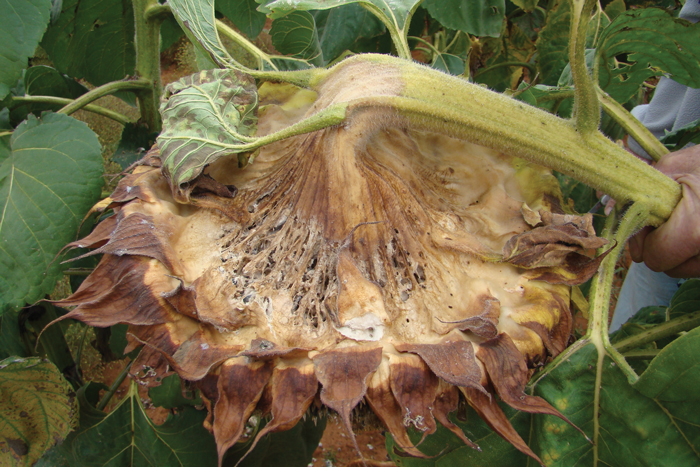
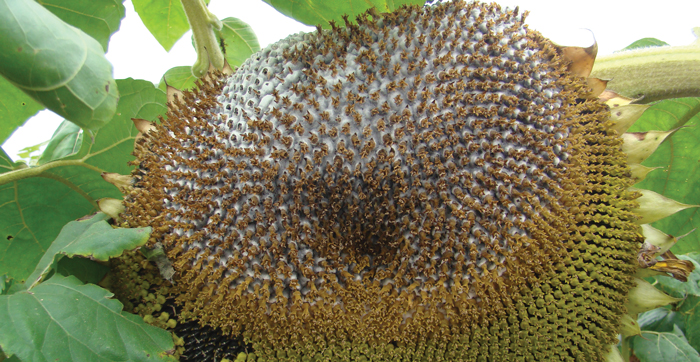
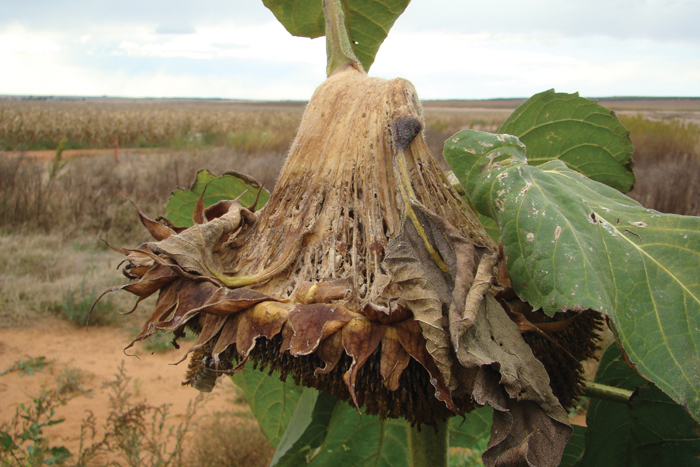
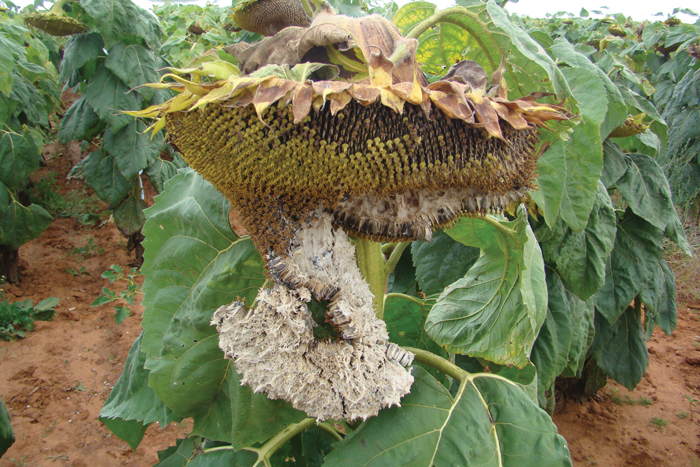
Stalk rot
Initial symptoms occur when sclerotia in the soil develop mycelia under certain climatic conditions. These mycelia infect the sunflower plant roots, extend into the stalk and result in sudden wilting of the plant, particularly during grain fill. The infection prevents the plant from taking up water and nutrients in the soil that are needed for growth and grain fill. At grain fill the demand for these increases, putting the plant under greater stress and resulting in wilting and death. A light brown water-soaked area at the stem base will become obvious and is the first sign of infection. The infected sunflower stem pith becomes a white cotton-like tissue, which includes mycelial growth within which large black sclerotia form (Photo 5). Stems often break at this point of infection. Heads do not fill out properly due to nutrients and water not being taken up by the plant, resulting in serious yield losses.
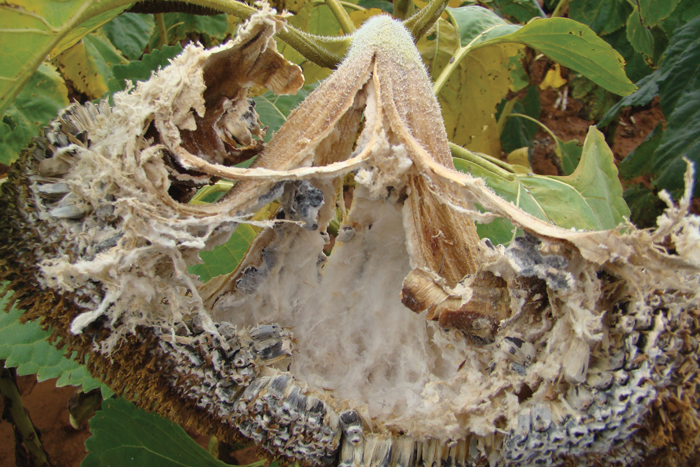
Biology of the two diseases
Head rot
During periods of high rainfall (such as the present situation) and cool temperatures during head fill, the disease is most prominent. Saturated soil results in the production of apothecia from germinating sclerotia (carpogenic germination). These apothecia (Photo 6) are small mushroom-like fruiting bodies and look similar to a golf tee (not to be confused with bird’s nest fungi that also form in fields). Apothecia form on the soil surface and release spores into the air, which are wind-borne and infect the sunflower head during wet weather. The spores use dead flower parts as a food source as they cannot infect healthy tissue. Once the fungus becomes established, it produces oxalic acid and extracellular enzymes, which kill and digest tissues and enable rapid ramification of the fungus throughout the sunflower head. Wounds on the back of the sunflower heads caused through mechanical damage by for instance birds, may become infection sites and initiate head rot.
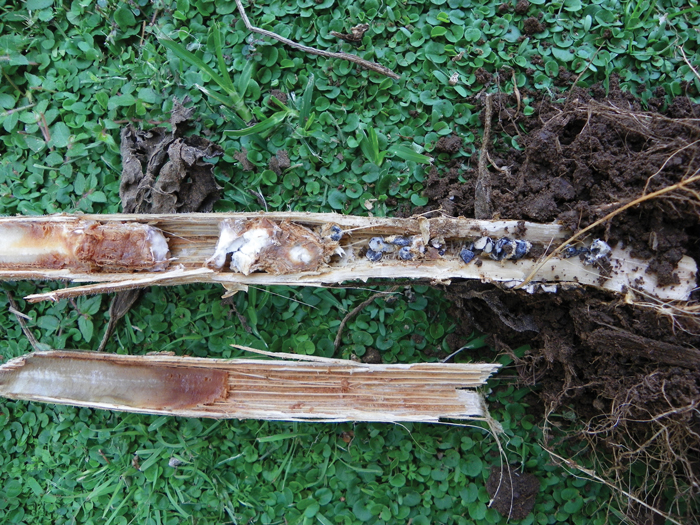
Stalk rot
The fungus overwinters as sclerotia in the soil, weeds and in plant debris. Sclerotia may survive for up to four to seven years in the soil. In summer, when sunflower roots are exposed to the sclerotia, the sclerotia germinate and infect the roots (myceliogenic germination). The fungus grows from the infected root into the taproot and forms a canker at the stem base. This infection prevents the plant from taking up water and
nutrients and the plant eventually wilts and dies. Adjacent plants may be infected by root-to-root contact with infected plants. Development of stalk rot is almost independent of weather conditions.
Control
Management
Sudden outbreaks of sunflower head rot may result in infestation of lands previously free or with low levels of Sclerotinia. Every season that an epidemic occurs, increases inoculum for the next season until disease levels become so high it becomes uneconomical to plant sunflowers on or near the field. These infestations restrict the producer’s options in terms of alternate crops to be used in rotation systems with maize due to the wide host range infected by Sclerotinia. The infested fields are an increased threat to following sunflower or soybean crops planted in rotation with maize.
Since Sclerotinia stalk rot may occur irrespective of weather conditions, inoculum levels may increase annually until conditions are again favourable for Sclerotinia head rot. The suggested norm is to avoid planting sunflowers or other host crops on infested lands for five to eight years. Under local production conditions, this may entail planting maize under monoculture for at least five seasons. Crop rotation with non-hosts will reduce stalk rot more significantly than head rot. Head rot can still develop from wind-borne spores blown in from surrounding areas.
Deep burial of sclerotia prevents them from producing apothecia. One must avoid bringing these buried sclerotia to the surface in following seasons. Once they return to the soil surface and are still viable, they can again cause either head rot or stalk rot. Deep burial as well as planting of other carefully selected non-host crops in rotation with maize will reduce inoculum levels dramatically. Unfortunately, very few non-host crops are available in practice to make this economically viable. Monoculture maize or sorghum can result in increased levels of other diseases of these non-host crops such as stalk and ear rots.
Resistance
Tolerance to stalk and head rot does occur, but is limited in efficacy. Genotypes that have been screened annually in the USA (North Dakota), indicate slow but gradual progress in USA breeding programs. Genotypes may be tolerant to head rot and not stalk rot and vice versa. No genotype is resistant and inoculated trials in North Dakota showed Sclerotinia head rots to vary from approximately 35% to 60%, with confectionary sunflowers (not grown in South Africa) generally being less tolerant. Tolerance is influenced by varying weather conditions, but the relative ranking of hybrids stays the same, just more or less disease occurs. Locally genotypes need to be screened on a consistent basis using reliable inoculation techniques and mechanisms of tolerance need to be determined for significant progress to be made for use in local management systems.
Chemical control
Desiccants resulting in early dry down may be sprayed on infected crops (after physiological maturity but before the levels of Sclerotinia head rot reach damaging levels) to reduce the impact of further development of head rot and sclerotial development (next season’s inoculum). Ensuing weather conditions may influence the efficacy of desiccants as wet weather may favour head rot after the plants have dried due to the affinity of the pathogen for dead tissue. This means that once the plants have dried adequately, harvesting needs to commence immediately. Leaving dried crops on the field will just result in higher disease levels. Future weather conditions need to be forecasted prior to a decision regarding use of desiccants can be made.
Benomyl used as a seed treatment is the only currently registered fungicide on sunflowers in South Africa. Procymidone is registered on soybeans as a spray, but timing of the spray is critical and for sunflowers there are serious economic implications should it ever be registered. As individual florets develop over time, the timing of the spray will be critical as will its length of efficacy. This aspect needs to be thoroughly researched before being included in management systems.
Biological control
Researchers at the ARC-Grain Crops were involved in the initial evaluation of various biological control products for use in South Africa. One product, Contans, in particular showed to have good potential for control. Bayer, now Corteva, purchased the original company that developed the mycoparasitic Contans fungus, Coniothyrium minitans strain CON/M/91-08, and markets the product. As with any biological control product, these living organisms are influenced by environmental conditions in terms of efficacy.
Broadleaf weed and volunteer sunflower control
Control of broadleaf weeds and volunteer sunflowers reduces possible inoculum increase by reducing possible alternate hosts of Sclerotinia. The importance of keeping fields clean of weeds and volunteer plants before planting and during the growing season cannot be overemphasised. This reduces initial infections that can infect the present crop.
Planting
Plant sunflowers early to avoid wet, cool conditions during flowering so as to reduce head rot infections. Avoid planting sunflowers next to infested fields that could be a source of spores. Plant clean sunflower seed as infected seed may be a primary source of inoculum in uninfected fields.
Summary
Sclerotinia head and stalk rot are a significant threat to the local sunflower industry – particularly in wet seasons. Although there has been a lot of research done on this disease, very few management solutions have been developed. Research on inoculation techniques, tolerance, mechanisms of tolerance, chemical control and timing thereof with use of prediction models and feasibility of biological control systems need to be researched in more detail and the accuracy must be improved.
It is critical to reduce the threat of Sclerotinia in local crop production due to its wide host range and ability to survive. Increased occurrence and incidence of this pathogen on susceptible hosts will also impact on the maize and sorghum industries in reducing options for maize/sorghum crop rotation systems. It will also impact on maize/sorghum prices should large areas of arable land be planted to monoculture maize/sorghum. Should the present rains persist well into the season, producers can expect increased Sclerotinia head rots this season.

SASRN appreciates the participation of the producers in the abovementioned online survey, which is supported by Grain SA, the Department of Science and Innovation (DSI) and the Oil and Protein Seeds Development Trust (OPDT). To participate in the online survey, please click on the QR code or visit http://sclerotinia.co.za/survey. Sunflower producers are requested to take part in the online survey so that SASRN can obtain reliable feedback over various seasons on the estimated damage and potential yield loss caused by this devastating disease. Producers’ feedback will be greatly appreciated.
 For more information contact Dr Lisa Rothmann, administrator of SASRN, at the University of the Free State on 079 270 9691. Producers may also contact Dr Bradley Flett of the ARC-Grain Crops at 082 920 9733 for further advice.
For more information contact Dr Lisa Rothmann, administrator of SASRN, at the University of the Free State on 079 270 9691. Producers may also contact Dr Bradley Flett of the ARC-Grain Crops at 082 920 9733 for further advice.





























